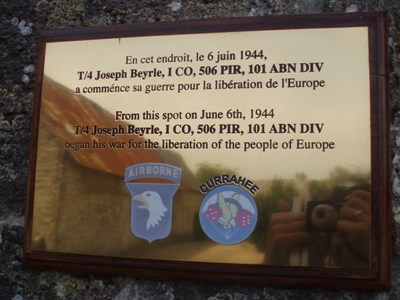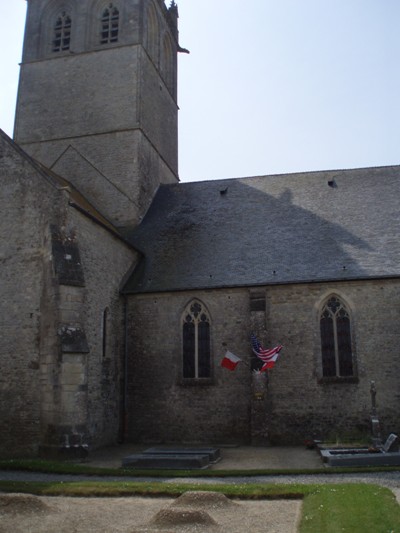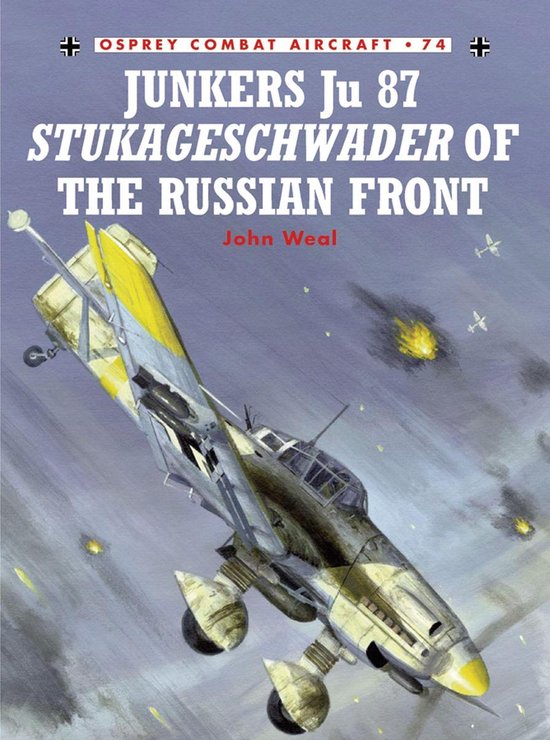Memorial Joseph Beyrle
On 6 June 1944, Joe (Joseph) Beyrle landed on the roof of this church in Saint-Côme-du-Mont. From here he started his own war to free Europe.
On June 6, D-Day, Beyrle's C-47 came under enemy fire over the Normandy coast and he was forced to jump from the exceedingly low altitude of 120 meters. After landing in St. Côme-Du-Mont, Sergeant Beyrle lost contact with his fellow paratroopers, but succeeding in blowing up a power station. He performed other sabotage missions before being captured by German soldiers a few days later.
Over the next seven months, Beyrle was held in seven different German prisons. He escaped twice, only to be recaptured each time. Beyrle and his fellow prisoners had been hoping to find the Soviet army, which was a short distance away. After the second escape (in which he and his companions set out for Poland but boarded a train to Berlin by mistake), Beyrle was turned over to the Gestapo by a German civilian. Beaten and tortured, he was released to the German military after officials stepped in and determined that the Gestapo had no jurisdiction over prisoners of war. The Gestapo were about to shoot Joe and his comrades, claiming that he was an American spy who had parachuted into Berlin.
Beyrle was taken to the Stalag III-C POW camp in Alt Drewitz, from which he escaped in early January 1945. He headed east, hoping to meet up with the Soviet army. Encountering a Soviet tank brigade in the middle of January, he reportedly held up his hands up, holding a pack of "Lucky Strikes" and shouted in badly spoken Russian, 'Amerikansky tovarishch! Amerikansky tovarishch! ("American comrade!"). Beyrle was eventually able to persuade the brigade's commanders into letting him fight alongside the unit on its way to Berlin, thus beginning his month-long stint in a Soviet tank battalion where his demolitions expertise was appreciated.
Beyrle's new battalion was the one that freed his former camp, Stalag III-C, at the end of January, but in the first week of February, he was wounded during an attack by German Stuka dive bombers. He was evacuated to a Soviet hospital in Landsberg, where he received a visit from Soviet Marshal Georgy Zhukov, who, intrigued by the only non-Russian in the hospital, provided Beyrle with official papers in order to rejoin American forces.
Beyrle arrived at the U.S. Embassy in Moscow in February 1945, only to learn that he had been reported by the War Department as KIA on 10 June 1944 on French soil. A funeral mass had been held in his honor in Muskegon and his obituary was published in the local newspaper. Embassy officers in Moscow, unsure of his bona fides, placed him under Marine guard in the Metropol Hotel until his identity was established through his fingerprints.
Do you have more information about this location? Inform us!
Source
- Text: Serjos de Groot
- Photos: Serjos de Groot
Related books
Nearby
Museum
- D-Day Experience - Dead Man's Corner Museum - Saint-Côme-du-Mont
- Normandy Victory Museum - Catz/St Pellerin
- The Airborne Museum - Sainte-Mère-Église
Point of interest
- L'église Saint-Côme-et-Saint-Damien - Angoville Au Plain
- Headquarters Maxwell D .Taylor - Hiesville
- Bailey Bridge Saint-Hilaire-Petitville - Carentan
Monument
- Memorial Lt. Col. Robert Wolverton - Carentan les Marais
- 2nd Combat Medics (501 PIR) Memorial - Angoville Au Plain
- Memorial Stone Toccoa - Angoville Au Plain
Cemetery
Fortification
- Stützpunkt 108 Heeres-Küsten-Batterie Saint-Martin-de-Varreville - Saint-Martin-de-Varreville
- Atlantikwall - Gun Emplacement (W.N. 5) - La Madeleine
- Atlantikwall - Gun Emplacement 5cm KwK (W.N. 5) - La Madeleine













